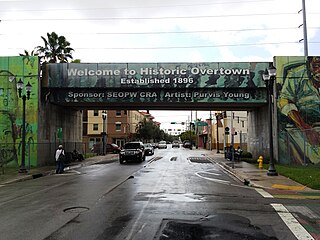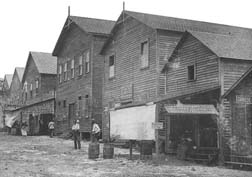
Gentrification is the process of changing the character of a neighborhood through the influx of more affluent residents and investment. There is no agreed-upon definition of gentrification. In public discourse, it has been used to describe a wide array of phenomena, usually in a pejorative connotation.

Coconut Creek is a city in Broward County, Florida, United States. Situated 37 miles (60 km) north of Miami, it had an estimated population of 57,348 in 2022. It is part of South Florida's Miami metropolitan area. The city seceded from Pompano Beach in the 1960s. It is nicknamed "Butterfly Capital of the World" because it is home to Butterfly World, the world's largest butterfly aviary, with over 80 species and 20,000 individual butterflies.

Coconut Grove, also known colloquially as “The Grove,” is an affluent and the oldest continuously inhabited neighborhood of Miami in Miami-Dade County, Florida. The neighborhood is roughly bounded by North Prospect Drive to the south, LeJeune Road to the west, South Dixie Highway and Rickenbacker Causeway to the north, and Biscayne Bay to the east. It is south of the neighborhoods of Brickell and The Roads and east of Coral Gables. The neighborhood's name has been sometimes spelled "Cocoanut Grove" but the definitive spelling "Coconut Grove" was established when the city was incorporated in 1919.

Little Haiti, is a neighborhood of Miami, Florida, United States. It is known historically as Lemon City, Little River and Edison. It is home to Haitian immigrant residents, as well as residents from the rest of the Caribbean.
Bahamian Americans are an ethnic group of Caribbean Americans of Bahamian ancestry. There are an estimated 56,797 people of Bahamian ancestry living in the US as of 2019.

Overtown is a neighborhood of Miami, Florida, United States, just northwest of Downtown Miami. Originally called Colored Town in the Jim Crow era of the late 19th through the mid-20th century, the area was once the preeminent and is the historic center for commerce in the black community in Miami and South Florida.

Thousands of years before Europeans arrived, a large portion of south east Florida, including the area where Miami, Florida exists today, was inhabited by Tequestas. The Tequesta Native American tribe, at the time of first European contact, occupied an area along the southeastern Atlantic coast of Florida. They had infrequent contact with Europeans and had largely migrated by the middle of the 18th century. Miami is named after the Mayaimi, a Native American tribe that lived around Lake Okeechobee until the 17th or 18th century.

Liberty Square, often referred to as the Pork & Beans, is a 753-unit Miami-Dade public housing apartment complex in the Liberty City neighborhood of Miami, Florida. It is bordered at Martin Luther King Jr. Boulevard/North 62nd Street to the south, North 67th Street to the north, State Road 933 to the east, and Northwest 15th Avenue to the west. Constructed as a part of the New Deal by the Public Works Administration and opening in 1937, it was the first public housing project for African Americans in the Southern United States. It is featured in the 2023 documentary film, Razing Liberty Square.

Downtown Miami is the urban city center of Miami, Florida, United States. The city's greater downtown region consists of the Central Business District, Brickell, the Historic District, Government Center, the Arts & Entertainment District, and Park West. It is divided by the Miami River and is bordered by Midtown Miami's Edgewater, and Wynwood sections to its north, Biscayne Bay to its east, the Health District and Overtown to its west, and Coconut Grove to its south.

Wynwood is a neighborhood in Miami, Florida. Wynwood is known for being an entertainment district, with artwork, restaurants, breweries, clothing stores, and dance venues, among other retail options. Formerly an industrial district, the area is now known for the murals that cover the walls of many of the buildings and many of the sidewalks. It is north of Downtown Miami and Overtown, and adjacent to Edgewater. Wynwood has two major sub-districts, the Wynwood Art District in northern Wynwood, and the Wynwood Fashion District along West 5th Avenue. Wynwood roughly is divided by North 20th Street to the south, I-195 to the north, I-95 to the west and the Florida East Coast Railway to the east.

Haiti has a sizable diaspora, present primarily in the United States, Panama, Dominican Republic, Cuba, Canada, France, the Bahamas, Peru, Ecuador, Colombia, Brazil and Chile. They also live in other countries like Costa Rica, Mexico, Bolivia, Guatemala, Nicaragua, Honduras, Venezuela, Argentina, Barbados, Dominica, Suriname, Aruba, Guyana, Belgium, Switzerland, United States Virgin Islands, Turks and Caicos Islands, among others.

A conch house is a style of architecture that developed in Key West, Florida in the 19th century and used into the early 20th century. The style was also used in the other keys and in the Miami area. The introduction of the conch house style is attributed to immigrants from the Bahamas.

Peacock Park is a 9.4-acre (3.8 ha) public, urban park where Indian peacocks roam in the Coconut Grove neighborhood of Miami, Florida on the shore of Biscayne Bay.

Charlotte Jane Memorial Park Cemetery formerly known as Coconut Grove Bahamian Cemetery, is a historic cemetery in Miami, Florida where many Bahamian settlers were buried.
Gentrification, the process of altering the demographic and socioeconomic composition of a neighborhood usually by decreasing the percentage of low-income minority residents and increasing the percentage higher-income residents, has been an issue between the residents of minority neighborhoods in Chicago who believe the influx of new residents destabilizes their communities, and the gentrifiers who see it as a process that economically improves a neighborhood. Researchers have debated the significance of its effects on the neighborhoods and whether or not it leads to the displacement of residents.
Race riots in Miami include a series of violent events that occurred in Miami mainly through the 1980s. After desegregation, much of the racial violence in Miami had calmed only to be reignited by the 1980s. The decade of riots were the result of policing controversies and ethnic tensions fueled by the perceived threat of recent immigrants to African Americans on the Miami job market.

The gentrification of Baltimore, Maryland, began in 2000 and continues to transform the city by redeveloping specific neighborhoods to appeal to wealthier residents. Due to Baltimore's large amount of gentrification, the city accounts for a significant amount of the United States gentrification. The gentrification of Baltimore has occurred throughout the city, but particularly in the neighborhoods surrounding the Inner Harbor in Central Baltimore and East downtown Baltimore. The gentrification of Baltimore has occurred through the addition of new housing, increased commercial spaces, and more. The transformation that has occurred throughout the city of Baltimore has many benefits as it improves the city in various ways. However, many others feel that gentrification is unfavorable for Baltimore because it displaces current residents from their homes due to rising prices in newly gentrified neighborhoods.
Climate gentrification is a subset of climate migration, in which certain lower-socioeconomic communities are displaced in place of housing for more wealthy communities. Areas affected by this phenomenon are typically coastal cities, islands, and other vulnerable areas that are susceptible to rising sea levels, extreme weather events, and other climate-related disasters.
Alicia Cervera is a Peruvian-American businesswoman, real estate broker and philanthropist known for her work as the founder and chairman of Cervera Real Estate, a real estate brokerage firm headquartered in Miami, Florida. Cervera has worked alongside notable developers including Harry Helmsley and Jorge M. Perez. She has been compared to Julia Tuttle as one of the women whose impact on the development of Miami has been the most prolific."
Eddie Arroyo is an American visual artist working primarily with landscape painting. His canvases often depict urban scenes and local reference points for the South Florida communities as way to comment on economic and social issues such as gentrification, migration, and intergenerational relationships.














